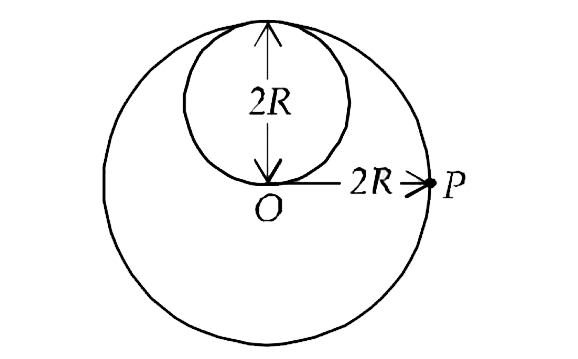Statement I: Intensity of sound wave changes when the listener moves towards or away from the stationary source.
Statement II: The motion of listener causes the apparent change in wavelength.
Statement I is true, Statement II is true: Statement II is a correct explanation for statement I.
Statement I is true, Statement II is true, Statement II is NOT a correct explanation for Statement I.
Statement I is true, Statement II is false
Statement I is falce: Statement II is true
The correct Answer is:C
Intensity of sound at any point is dependent upon frequency as well as amplitude. As due to Doppler effect the apparent frequency changes, so intensity as perceived by the listener also changes. When listener is moving wavelength remains the same.
Topper's Solved these Questions
- SOUND WAVES AND DOPPLER EFFECTBook:CENGAGE PHYSICSChapter:SOUND WAVES AND DOPPLER EFFECTExercise:Comprehension
Explore 144 Videos
- SOUND WAVES AND DOPPLER EFFECTBook:CENGAGE PHYSICSChapter:SOUND WAVES AND DOPPLER EFFECTExercise:Integer
Explore 16 Videos
- SOUND WAVES AND DOPPLER EFFECTBook:CENGAGE PHYSICSChapter:SOUND WAVES AND DOPPLER EFFECTExercise:Multiple Correct
Explore 44 Videos
- RIGID BODY DYNAMICS 2Book:CENGAGE PHYSICSChapter:RIGID BODY DYNAMICS 2Exercise:Interger
Explore 2 Videos
- SUPERPOSITION AND STANDING WAVESBook:CENGAGE PHYSICSChapter:SUPERPOSITION AND STANDING WAVESExercise:Comprehension Type
Explore 5 Videos
Similar Questions
A railroad train is travelling at 30ms in still air. The frequency of the note emitted by locomotive whistle is 500 Hz. Speed of sound is 345ms.
Q. What is the frequency of the sound waves heard by a stationary listener in front of the train?
View SolutionThe average power transmitted across a cross section by two sound waves moving in the same direction are equal. The wavelength of two sound waves are in the ratio of 1:2, then find the ratio of their pressure amplitudes.
View SolutionWhich of the following statements are incorrect?
View SolutionA lamina is made by removing a small disc of diameter 2R from a bigger disc of uniform mass density and radius 2R, as shown in the figure. The moment of inertia of this lamina about axes passing though O and P is IOandIP respectively. Both these axes are perpendicular to the plane of the lamina. The ratio IPIO ot the nearest integer is

View SolutionA string of length L, fixed at its both ends is vibrating in its 1st overtone mode. Consider two elements of the string of the same small length at positions l1=0.2Landl2=0.45L from one end.
If K1andK2 are their respective maximum kinetic energies,then
View SolutionStatement I: Intensity of sound wave changes when the listener moves towards or away from the stationary source.
Statement II: The motion of listener causes the apparent change in wavelength.
View SolutionStatement-1: Due to the motion of listener, the frequency of the sound waves (as received by listener) emitted by stationary source is affected
Statement-2: Due to the motion of source, wavelength of the sound waves (emitted by source) as received by stationary listener is affected.
Statement-3: If recever and source both are moving, the observed frequency must be different from the original frequency of source. Treat motion of source or listener as always along a line joining them for all above cases.
View Solutionएक ध्वनि स्रोत तथा श्रोता एक-दूसरे के सापेक्ष स्थिर है। यदि ध्वनि की चाल बदल जाये तो श्रोता द्वारा सुनी गयी ध्वनि की आवृत्ति तथा तरंग - दैर्ध्य में से किसमें परिवर्तन होगा ?
View Solutionएक ही दिशा में ध्वनि - स्रोत्र एवं श्रोता समान चाल से चल रहे है ध्वनि स्रोत्र तथा श्रोता एक - दूसरे के सापेक्ष स्थिर है। यदि ध्वनि की चाल बदल बदल जाए तो श्रोता द्वारा सुनी गई ध्वनि की आवृत्ति तथा तरंगदैर्घ्य में से किसमे परिवर्तन नहीं होगा।
View SolutionWhat is Doppler effect of sound? Derive expression for apparent frequency of sound. When source is moving away from stationary listener.
View SolutionWhat physical change occurs when a source of sound moves and listener is at rest?
View SolutionWhat physical change occurs when source of sound waves is at rest and the listener moves?
View SolutionStatement I: Intensity of sound wave changes when the listener moves towards or away from the stationary source.
Statement II: The motion of listener causes the apparent change in wavelength.
View SolutionStatement I : Intersity of sound wave change when the listener moves towerds or away from the stationary source . Statement II : The motion of listener causes the apparent change in wavelength.
View SolutionWhat is Doppler effect? Derive the formula for the change in apparent frequency (i) Both source and listener move towards and away from each other. (ii) Both source and listaner move one behind the other source follows the listener and listener follows the source. (iii) Source at rest, listener moves towards and away from the source. (iv) Listener at rest, source moves towards and away from the listener.
View Solution(A): Intesity of sound heard changes when an observer moves towards or away from a stationary source. (R): The motion of observer causes apparent change in wavelength.
View Solution
